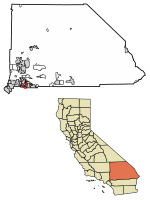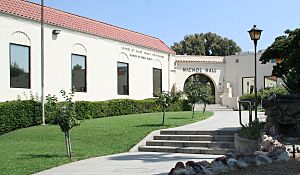Loma Linda, California facts for kids
Quick facts for kids
City of Loma Linda
|
|
|---|---|

A view of Loma Linda University Medical Center, with the city surrounding it
|
|
| Motto(s):
Serving Man
|
|

Location of Loma Linda in San Bernardino County, California
|
|
| Country | |
| State | |
| County | San Bernardino |
| Incorporated | September 29, 1970 |
| Government | |
| • Type | Council–manager |
| Area | |
| • Total | 7.64 sq mi (19.79 km2) |
| • Land | 7.64 sq mi (19.79 km2) |
| • Water | 0.00 sq mi (0.00 km2) 0.01% |
| Elevation | 1,165 ft (355 m) |
| Population
(2010)
|
|
| • Total | 23,261 |
| • Estimate
(2019)
|
24,482 |
| • Density | 3,204.45/sq mi (1,237.30/km2) |
| Time zone | UTC−8 (Pacific) |
| • Summer (DST) | UTC−7 (PDT) |
| ZIP Codes |
92350, 92354, 92357
|
| Area code | 909 |
| FIPS code | 06-42370 |
| GNIS feature IDs | 1660935, 2410857 |
Loma Linda (Spanish for "Beautiful Hill") is a city in San Bernardino County, California, United States, that was incorporated in 1970. The population was 23,261 at the 2010 census, up from 18,681 at the 2000 census. The central area of the city was originally known as Mound City, while its eastern half was originally the unincorporated community of Bryn Mawr.
Contents
History
In the late 1800s, Loma Linda began as a development of tourist halls called Mound City, as encouraged by railroad companies. In the early 1800s shops and cottages were built but the project would later fail. During the late 1890s, a group of businessmen and physicians from Los Angeles bought the hotel and reopened it as a convalescent home and health resort. They called it Loma Linda, meaning “pretty hill” in Spanish. The city was incorporated in 1970.
In 1969, San Timoteo Creek overflowed its banks, inundating two-thirds of Loma Linda. Many of the bridges over the creek washed away, and Loma Linda Academy was completely flooded. In 2010, the creek again flooded parts of Loma Linda.
Loma Linda is twinned with Manipal, India, and Libertador San Martin, Argentina, as its sister cities.
Geography
Loma Linda is located in southwestern San Bernardino County and is part of the Inland Empire. It is bordered on the north by San Bernardino, on the east by Redlands, on the west by Colton, and on the south by Riverside County. An area of unincorporated territory in Riverside County separates Loma Linda from the city of Moreno Valley to the south. The remnants of Bryn Mawr, an unincorporated community formerly located between Loma Linda and Redlands, were annexed by the City in 2008.
The city is in the southern San Bernardino Valley. The southern third of the city is known as the South Hills; this rugged and hilly area at the northwestern end of The Badlands is a city-owned open space reserve protected by a local initiative. San Timoteo Creek flows from southeast to northwest through the city.
According to the United States Census Bureau, the city has a total area of 7.5 square miles (19 km2), 99.99% of it land.
Water contamination and air pollution
Ground water near Loma Linda is contaminated by a plume of the chemical perchlorate which was used in the manufacture of solid rocket fuel. Also, this chemical was formerly (decades ago and in very small amounts) prescribed by physicians to control the overactive thyroid glands of certain patients. Attempts to quantify the effects of low-level exposure to perchlorate have met with resistance from environmental (and other) activists. A nearby plant operated by Lockheed Aerospace has been implicated in the improper disposal of the rocket fuel ingredient, which leached into the ground water northeast of Loma Linda. Loma Linda's municipal water supply, nevertheless, has been unaffected by the plume, primarily because Lockheed Martin installed a $19 million treatment plant in 2010 to remove both perchlorate and trichloroethylene from water after pumping it from the aquifer.
Demographics
| Historical population | |||
|---|---|---|---|
| Census | Pop. | %± | |
| 1970 | 9,797 | — | |
| 1980 | 10,694 | 9.2% | |
| 1990 | 17,400 | 62.7% | |
| 2000 | 18,681 | 7.4% | |
| 2010 | 23,261 | 24.5% | |
| 2019 (est.) | 24,482 | 5.2% | |
| U.S. Decennial Census | |||
2010
At the 2010 Census, Loma Linda had a population of 23,261. The population density was 3,094.3 people per square mile (1,194.7/km2). The racial makeup of Loma Linda was 47.8% White (11,122 people; 37.0% Non-Hispanic White); 8.7% African American (2,032 people); 0.4% Native American (97 people); 28.3% Asian (6,589 people); 0.7% Pacific Islander (154 people); 8.7% from other races (2,022 people); and 5.4% from two or more races (1,245 people). Hispanic or Latino of any race were 5,171 people (22.2%).
The census reported that 22,457 people (96.5% of the population) lived in households, 562 (2.4%) lived in non-institutionalized group quarters, and 242 (1.0%) were institutionalized.
There were 8,764 households, 2,650 (30.2%) had children under the age of 18 living in them, 3,832 (43.7%) were opposite-sex married couples living together, 1,190 (13.6%) had a female householder with no husband present, 461 (5.3%) had a male householder with no wife present. There were 351 (4.0%) unmarried opposite-sex partnerships, and 46 (0.5%) same-sex married couples or partnerships, while 2,453 households (28.0%) were one person and 837 (9.6%) had someone living alone who was 65 or older. The average household size was 2.56. There were 5,483 families (62.6% of households); the average family size was 3.18.
The age distribution was 4,859 people (20.9%) under the age of 18, 2,642 people (11.4%) aged 18 to 24, 7,463 people (32.1%) aged 25 to 44, 5,056 people (21.7%) aged 45 to 64, and 3,241 people (13.9%) who were 65 or older. The median age was 33.2 years. For every 100 females, there were 88.0 males. For every 100 females age 18 and over, there were 83.9 males.
There were 9,649 housing units at an average density of 1,283.6 per square mile, of the occupied units 3,432 (39.2%) were owner-occupied and 5,332 (60.8%) were rented. The homeowner vacancy rate was 2.5%; the rental vacancy rate was 9.9%. 9,496 people (40.8% of the population) lived in owner-occupied housing units and 12,961 people (55.7%) lived in rental housing units.
2000
At the 2000 Census, there were 18,681 people in 7,536 households, including 4,498 families, in the city. The population density was 2,541.7 people per square mile (981.3/km2). There were 8,084 housing units at an average density of 1,099.9 per square mile (424.7/km2). The racial makeup of the city was 54.2% White, 7.2% African American, 0.5% Native American, 24.4% Asian, 0.2% Pacific Islander, 7.5% from other races, and 6.1% from two or more races. Hispanic or Latino of any race were 16.3%.
Of the 7,536 households 27.1% had children under the age of 18 living with them, 43.7% were married couples living together, 12.0% had a female householder with no husband present, and 40.3% were non-families. Of all households 31.2% were one person and 10.5% were one person aged 65 or older. The average household size was 2.4 and the average family size was 3.1.
The age distribution was 21.9% under the age of 18, 10.2% from 18 to 24, 33.2% from 25 to 44, 19.2% from 45 to 64, and 15.4% 65 or older. The median age was 34 years. For every 100 females, there were 86.4 males. For every 100 females age 18 and over, there were 82.2 males.
The median household income was $38,204 and the median family income was $45,774. Males had a median income of $36,086 versus $35,096 for females. The per capita income for the city was $20,189. About 12.9% of families and 15.1% of the population were below the poverty line, including 18.6% of those under age 18 and 5.2% of those age 65 or over. Whether or not these poverty statistics include unemployed full-time students is not known.
Seventh-day Adventism
Loma Linda "is home to one of the largest concentrations of Seventh-day Adventists in the world." The Loma Linda University Church of Seventh-day Adventists, on the LLU campus, has one of the largest Adventist congregations in the world. Due to the large number of Loma Linda residents who are Seventh-day Adventists, the city was one of the few which had weekend mail delivery service on Sunday instead of Saturday. However, this distinction ended on April 23, 2011, when Saturday delivery resumed as part of a Post Office cost-cutting effort.
Since a popular practice of Seventh-day Adventists is vegetarianism, most restaurants in Loma Linda feature a vegetarian menu in addition to regular menu items. The Loma Linda Baker's Drive-Thru was the first in that fast-food chain to feature the "Loma Linda Kitchen" vegetarian menu. The chain has since dropped the Loma Linda name for the menu and expanded its vegetarian choices.
Longevity
Adventists in Loma Linda have one of the highest rates of longevity in the country; researcher Dan Buettner has labeled Loma Linda as a Blue Zone, an area where the longevity is appreciably higher than the national average and a substantial proportion of humans live past 100 years. Buettner's book, The Blue Zones: Lessons for Living Longer From the People Who've Lived the Longest, attributes Loma Linda's longevity rate to Adventist cultural health and diet practices. The city has strict controls on the sale of alcohol, has a ban on smoking, and the church-owned grocery store does not sell meat.
People
- Ellsworth Wareham - centenarian former surgeon and World War II veteran.
In popular culture
Loma Linda University Medical Center is featured in Venom ER, an Animal Planet program focusing on snakebite treatment at the hospital.
 |
San Bernardino | San Bernardino | Redlands |  |
| Colton | Redlands | |||
| Grand Terrace | Box Springs Mountains | Box Springs Mountains Redlands |
Education
The city of Loma Linda forms part of the Redlands Unified School District, with Bryn Mawr Elementary School being situated within Loma Linda city limits. However, the western edge of the city is served by the Colton Unified School District. Also located in the city are Loma Linda Academy, a K-12 school, and Loma Linda University (LLU), a health-sciences higher-learning institution, both run by the Seventh-day Adventist Church. Notable firsts at Loma Linda University's medical center include the first baboon-to-human heart transplant and the first split-brain surgery.
Notable people
- Baby Fae, first infant xenotransplant subject
- Brent Mayne, former catcher for the Kansas City Royals and San Francisco Giants.
- Matthew Modine, actor best known for his role in Full Metal Jacket
- Don Vesco, motorcycle racer in Motorsports Hall of Fame of America
- Loree Sutton, retired United States Army general and candidate in the 2021 New York City Democratic mayoral primary
- Ellsworth Wareham, centenarian former surgeon and World War II veteran.
See also
 In Spanish: Loma Linda para niños
In Spanish: Loma Linda para niños





